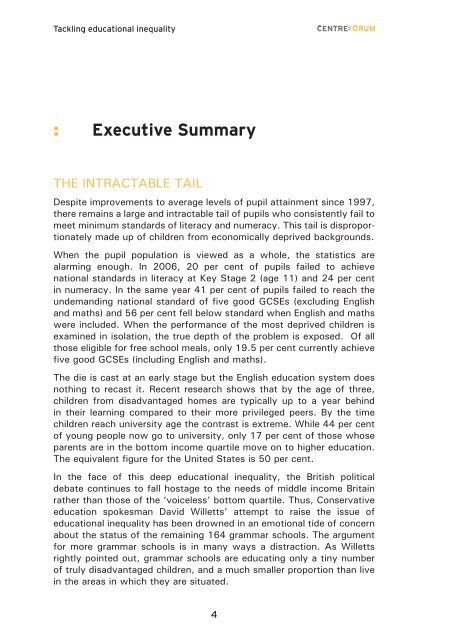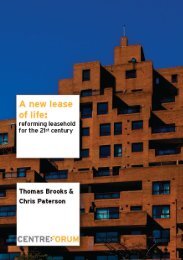Tackling educational inequality - CentreForum
Tackling educational inequality - CentreForum
Tackling educational inequality - CentreForum
Create successful ePaper yourself
Turn your PDF publications into a flip-book with our unique Google optimized e-Paper software.
<strong>Tackling</strong> <strong>educational</strong> <strong>inequality</strong><br />
:<br />
Executive Summary<br />
The intractable tail<br />
Despite improvements to average levels of pupil attainment since 1997,<br />
there remains a large and intractable tail of pupils who consistently fail to<br />
meet minimum standards of literacy and numeracy. This tail is disproportionately<br />
made up of children from economically deprived backgrounds.<br />
When the pupil population is viewed as a whole, the statistics are<br />
alarming enough. In 2006, 20 per cent of pupils failed to achieve<br />
national standards in literacy at Key Stage 2 (age 11) and 24 per cent<br />
in numeracy. In the same year 41 per cent of pupils failed to reach the<br />
undemanding national standard of five good GCSEs (excluding English<br />
and maths) and 56 per cent fell below standard when English and maths<br />
were included. When the performance of the most deprived children is<br />
examined in isolation, the true depth of the problem is exposed. Of all<br />
those eligible for free school meals, only 19.5 per cent currently achieve<br />
five good GCSEs (including English and maths).<br />
The die is cast at an early stage but the English education system does<br />
nothing to recast it. Recent research shows that by the age of three,<br />
children from disadvantaged homes are typically up to a year behind<br />
in their learning compared to their more privileged peers. By the time<br />
children reach university age the contrast is extreme. While 44 per cent<br />
of young people now go to university, only 17 per cent of those whose<br />
parents are in the bottom income quartile move on to higher education.<br />
The equivalent figure for the United States is 50 per cent.<br />
In the face of this deep <strong>educational</strong> <strong>inequality</strong>, the British political<br />
debate continues to fall hostage to the needs of middle income Britain<br />
rather than those of the ‘voiceless’ bottom quartile. Thus, Conservative<br />
education spokesman David Willetts’ attempt to raise the issue of<br />
<strong>educational</strong> <strong>inequality</strong> has been drowned in an emotional tide of concern<br />
about the status of the remaining 164 grammar schools. The argument<br />
for more grammar schools is in many ways a distraction. As Willetts<br />
rightly pointed out, grammar schools are educating only a tiny number<br />
of truly disadvantaged children, and a much smaller proportion than live<br />
in the areas in which they are situated.





